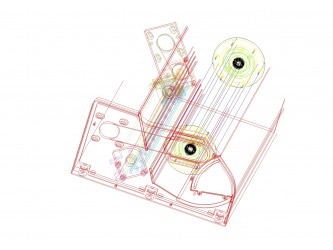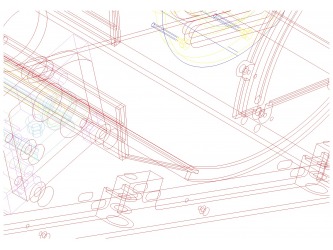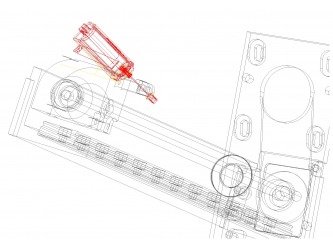Nuno Pedrosa
October 2009
Project
ISO2768-mH
It could seem a bit out of phase to come up with a display of exploratory sketches within a context where the practice of drawing is firmly understood as a reflexive activity in its own right rather than a by-product of any of the more dominant arts. Contrarily to the conventional view, which takes it for granted the honorable if ambiguous status of this discipline as a foundation-stone for the various other visual arts, drawing as an art form is ever more understood as an autonomous field whose significance relies more and more on its saliencies rather than on its celebrated qualities as the single most important tool in the artist’s workshop. It certainly is a full-fledged paradox the business of a discipline in the making at a time of widespread disciplinary dissolution, being sure thing however the proviso that an exhibition of purely industrial drawings could be possible only within the framework of an increased hybridism.
Likewise, it could not be more at odds with a spectatorship that expects way more than just a one-dimensional display of skills, the prospect of an exhibition comprised of drawings of the presentation vein only. It certainly is perplexing and somewhat frightening just to visualize one such picture. And if it is unproblematic to imagine these drawings within the context of an installation somehow, the same may not apply that easily to the event of an art show devoted solely to this kind of drawings. This exact same word of caution could justly be offered, if not more so, in the event of an exhibition comprised of dimensional drawings. It is only surprising then, that I would choose to exhibit a series of one such drawings knowing only too well that the simple act of displaying them could not be more at odds with their own nature and the nature of the place where they were being displayed.
The truth is, the more I dwelt with them the more difficult it became to justify to myself their being exhibited in one such setting. Their being displayed at all seemed utterly preposterous indeed, for the rationale of these drawings is one of communicating as precise a set of instructions as possible. There clearly is no emphasis on the element of process and no credit is granted to randomness whatsoever. As to the immediacy of expression, it is nowhere to be found either. The conceptual twist is non-existent and the tiniest visible evidence that they could be somewhat self-reflexive is missing altogether. In brief, there should be no reason for anyone to take them for something else other than what they have been right from the very start then, an unabashed series of illocutionary acts of the directive kind.
As it so happens, dwelling on these drawings and the uneasiness that comes out from it could only be advantageous at a time when the expanded field seems to have become a bit too narrow and predictable. It could very well be that, beyond an all too familiar profusion of cross-disciplinary practices, there persists a containment that can only be overcome at a deeper level of engagement. That this same containment is at the very bosom of our troublesome relation with these drawings is not entirely unexpected, but this awareness alone does little if anything to placate our disquiet. So as to cushion their landing somehow then, I will be submitting an additional series of drawings with a makeup a bit more concomitant with the current spectatorship. It will be their main purpose to elicit a few questions as well, but only within the strict limits of what is suggested by the source material itself.
One of these questions begins with the digital model for the “Transducer” piece and goes on to explore the possibilities and dilemmas of computer assisted drawing. For easiness of understanding, it suffices to imagine the “Transducer Drawing” as a snapshot of a four-dimensional event. Not unlike bullet-time, a single moment in time unfolds into several different views of the same object. The third person singular is not without reason thus, for this series is but one drawing in spite of what may look like on a first glance. The next series, the “ISO2768-mH” drawings, can be seen as a mise en abyme implement of sorts, only that the mirroring brings about variation instead of infinite, flawless replication. Beyond that, the true action takes place where the enforcement of constraint meets with the imponderable forces of the natural gesture.
This same measuring of forces can be found at work in the one and only collection of drawings that will be produced on location during residency, the somewhat compulsive series that go by the name of “Parallelism”. The script could not be more straightforward, a fixed but reasonable number of lines are drawn parallel to each other at regular spaces of one millimeter. The exact same exercise is repeated four times in a row on different but similar surfaces with the sole help of a ruler. Where parallelism and linear accuracy are concerned, the nominal values encoded by international standard ISO2768 provide for aspects such as fatigue and disruption. What was once an unhindered gesture is now a measurable event, where even the unavoidable element of irregularity is kept under manageable margins of error. That is as much as one is allowed to expand oneself then, a fraction of a millimeter to both sides of the absolute zero of expression.
Nuno Pedrosa, June 2009
CV



